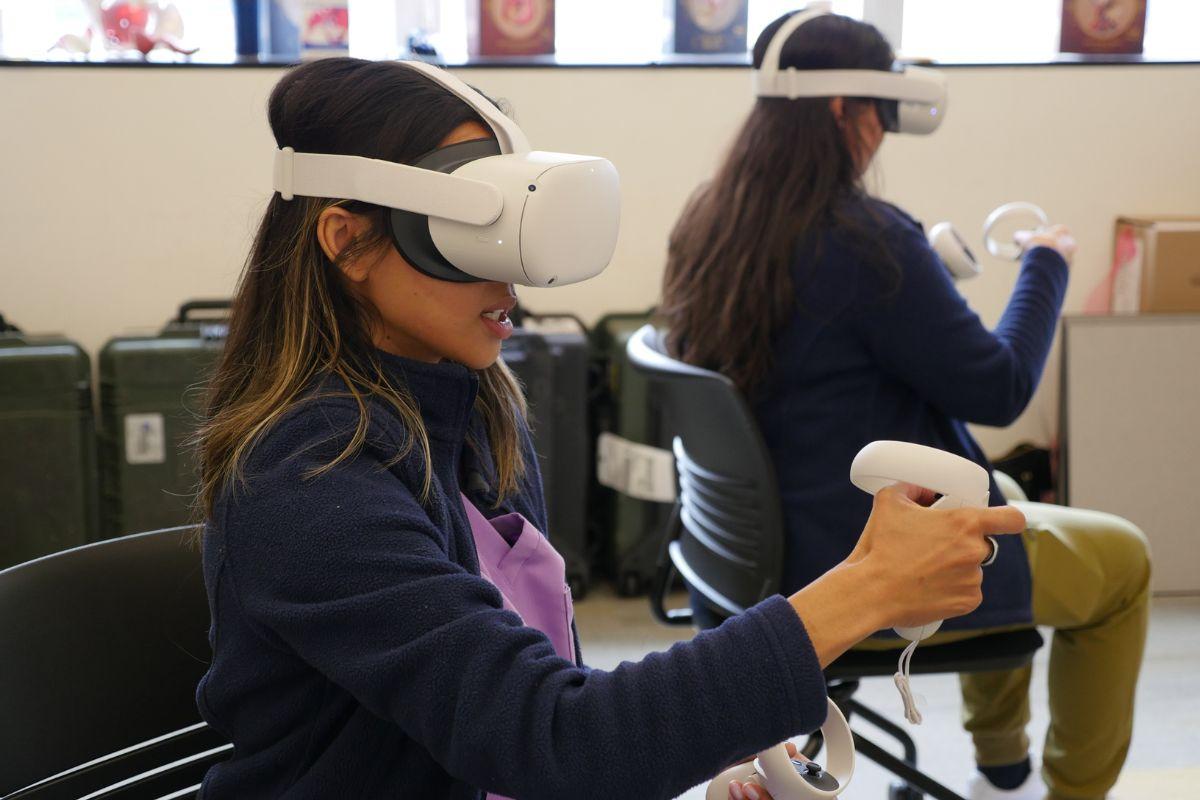
Melissa Im-Giuffrida, RN, and Lisa Magdaleno, RN, Master of Science program students, try a virtual reality application that will be used as part of a pilot program in the School of Nursing in academic year 2023-2024.
How Virtual Reality is Expanding Nursing Education
Imagine a midwifery student sitting in a classroom wearing a virtual reality (VR) headset. They are immersed in a realistic clinic environment, providing care to a patient experiencing postpartum hemorrhage – the leading cause of maternal morbidity globally.
Soon, students will be doing exactly that.
The UCSF School of Nursing is developing a VR pilot program to evaluate the usefulness of VR in training advanced practice nursing students, complementing the didactic education and hands-on clinical training that students currently receive at UCSF.
“VR provides exposure to critically important scenarios that nursing students may never experience in their clinical training,” explains Elizabeth Gatewood, DNP, RN, FNP, associate professor and assistant dean for Education Technology Innovation.
Funded through a $25,000 gift from a donor, the program is expected to launch as early as academic year 2023-2024.

Collaboration Expands Virtual Reality to Nursing Students
To prepare for the introduction of VR into educational programming, Gatewood is working with Program Analyst Pamela Dudzik, MPP, on two projects.
First, they are collaborating with Barbie Klein, PhD, assistant professor in the UCSF School of Medicine Department of Anatomy, and Rosalyn Plotzker, MD, MPH, assistant professor in the UCSF School of Medicine Department of Epidemiology and Biostatistics and faculty for the California Prevention Training Center, to explore the impact of a VR reproductive health application on nursing students’ learning.
The Virtual Approach to Gynecology, the application which Klein and Plotzker are developing, familiarizes early health care trainees with a gynecologic pelvic exam. Through virtual simulation, the user interacts with a patient and conducts a pelvic exam, including a Pap smear. A gamification element encourages repetition to improve performance.
If you've had some practice in the virtual realm, then when you're with the patient you can focus on them and their comfort." - Melissa Im-Giuffrida, RN, MS '23

“Learning requires imagination. Beyond memorization, students solidify their knowledge when they can mentally apply it to scenarios, visualize it and play with it,” says Plotzker. “I hope VR will support students’ imaginative processes by being a method for them to exercise their knowledge in a way that is interactive, immersive, realistic and accessible.”
This fall, Gatewood and Dudzik will use the application with a group of first-year master’s students in the School of Nursing. They will evaluate if VR improves learning and helps students feel more prepared to perform a gynecologic pelvic exam.
Differentiated Learning Through Virtual Reality
Concurrently, Gatewood and Dudzik will implement their second project – piloting another VR application that offers a library of diverse cases.
Learners and instructors can choose scenarios that are applicable to a particular nursing specialty or future practice setting. For example, a primary care nurse practitioner may choose a VR experience that allows them to interact with a patient who is newly diagnosed with diabetes, while a midwifery student participates in a VR scenario where they provide care to a patient experiencing postpartum hemorrhage.

Among the advantages of VR-based training is that it allows for differentiated learning and for students to repeat procedures and scenarios as many times as they want, Dudzik says. “Repetition is limited in real-life settings, but VR allows learners to repeat scenarios until they are competent in a scenario without impacting patient care experiences.” It also addresses the limitations of traditional simulation, like cost and time.
Gatewood and Dudzik will use findings from both projects to inform next steps for VR implementation in the School of Nursing.
Global Pandemic Inspires Education Innovation
Another benefit of VR is that students can be physically distanced while learning together – a benefit that is a priority for Gatewood, who was instrumental in ensuring continuity of instruction for the School of Nursing throughout the coronavirus pandemic.
In February 2020, Gatewood assumed the role of assistant dean, leading the school’s Educational Technology (EdTech) and Innovation Hub. She intended to spend four months developing a plan to enhance the school’s use of technology in learning – but COVID-19 had other ideas.
In mid-March, California announced a stay-at-home order. Like schools across the state, the School of Nursing quickly pivoted to remote learning, an experience Gatewood describes as “sprinting uphill.”
Gatewood and her team trained faculty on how to deliver coursework remotely. They implemented videoconferencing, telehealth, virtual patient simulation software and other technologies. Then, they shared what they learned with colleagues across the university.
Their efforts ensured that nursing students remained engaged and continued their academic progress uninterrupted.
“The pandemic fundamentally changed how education is delivered,” says Gatewood. Hybrid and remote learning opportunities have not only proved effective but are becoming more sophisticated.
Today, Gatewood and her team of educational technologists and instructional designers provide one-on-one and small group support to faculty, reviewing course learning outcomes and collaborating with faculty on ways to effectively integrate new technologies to meet those goals.
The team offers webinars on a variety of educational technology topics to ensure faculty are knowledgeable about the latest innovations. This spring, they hosted workshops on artificial intelligence including ChatGPT, teaching faculty about the technology and providing best practices for integrating it into courses.
“VR and artificial intelligence allow for sophisticated and immersive learning experiences,” says Gatewood. “I am excited about their potential to train the next generation of nurse leaders.”



